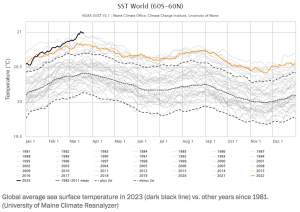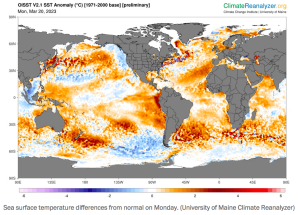Earth’s ocean temperatures have risen so fast in recent weeks that one indicator shows surface waters have already reached their highest temperatures on record — a worrisome sign ahead of a predicted El Niño climate pattern that could further accelerate planetary warming.
Earth’s oceans are showing early and surprising record warming – Washington Post – S. Birkel
The conditions are surprising and alarming to some meteorologists and climate scientists, although they say it is far too early to assume that a record year of oceanic or planetary warmth is ahead.
The data suggests, at least, that the planet, already beset with extreme warmth, is entering an expected stretch of accelerating heat.

The ocean temperature observations coincide with the release Monday of a definitive report from the United Nations Intergovernmental Panel on Climate Change asserting that drastic action is needed to slow global warming that has already irrevocably harmed ecosystems and communities. Earth’s temperatures are on a clear upward trajectory, already rising by at least 1.1 degrees Celsius (2 degrees Fahrenheit) since humans began burning fossil fuels to power industry.
The ocean data comes from a network of buoys, ships and satellites from which the National Oceanic and Atmospheric Administration collects daily data on the first few meters of ocean depth. The database — known as the NOAA 1/4° Daily Optimum Interpolation Sea Surface Temperature — shows a steady warming trend in sea surface water since the 1980s, with each of the past several years of data ranking well above all older data.
And it shows that 2023 is on pace at least to be yet another year among the warmest on record for the oceans. (Sea surface temperatures can vary according to weather, but across all depths, Earth’s oceans are gradually warming each year as they absorb more and more of the planet’s heat.)
“Global sea surface temperatures just reached uncharted territory in modern records and likely much longer,” Mika Rantanen, a researcher at the Finnish Meteorological Institute, wrote on Twitter.

Sea surface temperatures are predicted to rise further, at least in the Pacific Ocean, as forecast models suggest El Niño is more likely than not by late summer or early fall. El Niño is associated with higher-than-average sea surface temperatures in the equatorial Pacific.
El Niño can accelerate the steady rise in global temperatures because those warm Pacific waters translate to increased evaporation, which leads to increased cloud cover, which blocks sunlight from reaching Earth’s surface and encourages the trapping of heat in the atmosphere. It is known for discouraging Atlantic hurricane development but triggering extreme droughts and floods elsewhere.
The recent trend of rising ocean temperature is “probably the beginning of” a transition to El Niño from the relative cooling influence of La Niña, said Gavin Schmidt, a climatologist and the director of the NASA Goddard Institute for Space Studies. La Niña, which is marked by cooler-than-normal equatorial Pacific surface waters, had persisted for the past three years but ended last month.
But Boyin Huang, a NOAA oceanographer who focuses on sea surface temperature analysis, said that even if El Niño brings warmer Pacific waters, other oceans can counterbalance that trend. That means it’s too early to draw any conclusions about record sea surface warmth.
“There are other factors in other regions,” Huang said.
It also remains to be seen what other data sets show about conditions so far this year, including ones that also factor in the rapidly warming polar regions. Other observations are reported only monthly.
“I wouldn’t necessarily expect that this means 2023 will be a record-breaking year,” Schmidt said, although he added that it will “obviously be in the top 10” for sea surface warmth.
If “a fully fledged El Niño” arrives this year, however, climate scientists expect that a record-setting 2024 could follow.
As sea surface temperatures have ticked up in recent months, so has the temperature averaged over the Earth’s entire surface. The planet’s average temperature has increased from around 0.2 degrees Celsius above the 1991-2020 average in January to around 0.6 degrees above that level in mid-March. Conditions have been especially warm in Asia, eastern North America and Greenland.
Climate scientists expect that 2023 will be among the planet’s warmest years on record and think there is a 65 percent chance it ranks in the top five. Last year was Earth’s sixth-warmest year on record.

